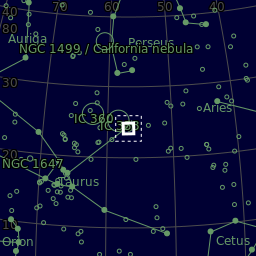The Pleiades or Seven Sisters (M45)
Descrizione – Description
Le Pleiadi o Le sette sorelle (Messier 45 o M45), sono un ammasso aperto contenente stelle di mezza età di tipo B, situato nella costellazione del Toro. E ‘tra i più vicini ammassi stellari alla Terra ed è il cluster più evidente ad occhio nudo nel cielo notturno. Il cluster è dominato da calde stelle blu estremamente luminose che si sono formate negli ultimi 100 milioni di anni. La polvere che forma una nebulosità debole attorno alle stelle più brillanti si pensava in un primo momento che fosse un residuo della formazione del cluster, ma ora è nota per essere una nube di polvere non collegata allo spazio interstellare, attraverso il quale le stelle stanno attualmente passando. Le simulazioni al computer hanno dimostrato che le Pleiadi si sono probabilmente formate da una configurazione compatta che somigliava la Nebulosa di Orione. Gli astronomi stimano che il cluster sopravviverà per circa altri 250 milioni di anni, dopo di che sarà disperso a causa delle interazioni gravitazionali con il suo vicinato galattico. Ripresa per una esposizione totale di 12h, con sub da 10 minuti per la luminanza e da 5 minuti per ogni canale RGB, tutti in binning 1×1 con Dithering e Drizzle integration.
The Pleiades or Seven Sisters (Messier 45 or M45), is an open star cluster containing middle-aged hot B-type stars located in the constellation of Taurus. It is among the nearest star clusters to Earth and is the cluster most obvious to the naked eye in the night sky. The cluster is dominated by hot blue and extremely luminous stars that have formed within the last 100 million years. Dust that forms a faint reflection nebulosity around the brightest stars was thought at first to be left over from the formation of the cluster, but is now known to be an unrelated dust cloud in the interstellar medium, through which the stars are currently passing. Computer simulations have shown that the Pleiades was probably formed from a compact configuration that resembled the Orion Nebula. Astronomers estimate that the cluster will survive for about another 250 million years, after which it will disperse due to gravitational interactions with its galactic neighborhood. Shooted for 12h of total exposure, with 10 min sub for luminance and 5 min sub for each RGB, all in binning 1×1 Dithered and Drizzle Integration.
Astrobin: http://www.astrobin.com/145483/
| Technical data | |
| Telescope | Takahashi FSQ106ED |
| Focal lenght | 530mm |
| Camera | Moravian G2-4000 |
| Integration | 35*600" Luminance - 25*300" each RGB |
| Coordinates | AR 03h 47m 24s - DEC +24° 07′ 17″ |
| Field size | 2.24×2.24 deg |
| Shooting date | 27-28-29-30 Sept 2014 |
Sky map

